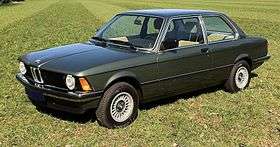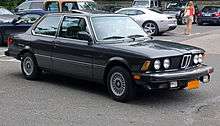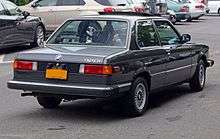BMW 3 Series (E21)
| BMW 3-Series - E21 | |
|---|---|
 | |
| Overview | |
| Manufacturer | BMW |
| Production |
1975–1983 1,364,039 built[1] |
| Assembly |
Munich, West Germany Kuching, Malaysia (SMI)[2] |
| Designer | Paul Bracq (1972) |
| Body and chassis | |
| Class | Entry-level luxury car |
| Body style |
2-door compact sedan 2-door convertible |
| Layout | FR layout |
| Powertrain | |
| Engine |
1.6 L M10 4-cyl 1.8 L M10 4-cyl 2.0 L M10 4-cyl 2.0 L M20 6-cyl 2.3 L M20 6-cyl |
| Transmission |
3-speed automatic 4-speed manual 5-speed manual |
| Dimensions | |
| Wheelbase | 2,563 mm (100.9 in) |
| Length |
4,355 mm (171.5 in) / 4,508 mm (177 in) with US bumpers |
| Width | 1,610 mm (63.4 in) |
| Height | 1,380 mm (54.3 in) |
| Chronology | |
| Predecessor | 02 Series |
| Successor | E30 |
BMW E21 is the first generation of the BMW 3 Series compact luxury vehicle, produced by the German automaker BMW from 1975-1983. It was released as 316, 318 and 320 models,[3] to replace the 02 Series. Production concluded when its replacement, the BMW E30, was released in 1982.
Most E21s were sold as 2-door compact sedans, however a Baur cabriolet was also available. Initially, the E21 was powered by a 4-cylinder engine, with a straight-6 engine added to the line-up in 1977.
Development
Under the direction of its 51% percent shareholder, Herbert Quandt, BMW decided upon a replacement for their aging 02 Series. Paul Bracq, Director of Design at BMW from 1970 to 1974, is credited with setting the design direction of the E21.
In July 1975, BMW’s Board of Management first presented this new model series in the Munich Olympic Stadium for public appraisal.
Design
The frontal view of the new car was dominated by the BMW trademark kidney grille standing out clearly from the radiator cover. The styling of the new car bore a resemblance to the BMW E12 5 Series.
The wedge shape of the two-door model was distinctive, extending all the way to the unusually high rear end. In response to criticism of the tail design, a black plastic trim panel between the tail lights was added. Like many other BMW models, the C-pillar of the E21 features a Hofmeister kink.
The cockpit design of the E21 marked the introduction of a new design concept, with the center console and central dashboard area angled towards the driver. This feature has become part of BMW’s interior design philosophy for many years. As a sign of passive safety, all edges and control elements within the interior were rounded off and padded.
Engineering
Measuring 4,355 mm (171 in) long, 1,610 mm (63 in) wide, and 1,380 mm (54 in) high, the E21 continued the tradition of the New Class 2-door sedan models. With the wheelbase measuring 2,563 mm (101 in), there was little body overhang in the rear-wheel-drive design. The track measured 1,364 mm (54 in) at the front, and 1,377 mm (54 in) at the rear.
The suspension incorporated rack and pinion steering and MacPherson strut suspension at the front, and semi-trailing arm type independent suspension at the rear. The rear suspension design causes camber changes, which can introduce "snap oversteer" at the handling limits.[4] The power assisted brakes were discs on the front wheels, while the rear wheels had drum brakes (except the 323i model which also run discs).
Initially, a Getrag four-speed manual was the standard transmission fitment. Five-speed overdrive Getrag gearboxes were fitted as standard in 1980, but close ratio 'sport' gearboxes were available at the car's release as an option. Alternatively, purchasers could opt for the ZF 3 HP-22 three-speed automatic transmission.
Models
Initial release
At the E21's release, three models were available: with 316 (1.6-litre), 318 (1.8-litre) and 320 (2.0-litre) versions of the BMW M10 4-cylinder engine. To differentiate between models, the 320 model came with dual headlights, while the 316 and 318 had single headlights.
| Model | Years | Engine | Power | Headlights | Notes |
|---|---|---|---|---|---|
| 316 | 1975-1980 | 1.6 L M10 carb | 66 kW (89 hp) | Single | Base model |
| 318 | 1975-1980 | 1.8 L M10 carb | 73 kW (98 hp) | Single | |
| 320 | 1975-1983 | 2.0 L M10 carb | 92 kW (123 hp) | Twin | Solex 2-barrel downdraft carburetor |
Model updates
.jpg)
The fuel-injected 320i was introduced at the end of 1975. It featured the M10 4-cylinder engine with Bosch K-Jetronic fuel injection, and a limited slip differential was available as an option.
At the 1977 International Auto Show in Frankfurt, BMW unveiled its new variants of the E21, featuring the new straight-6 M20 engines (which were initially called "M60"). BMW had invested DM 110 million the M20 engine series. The 4-cylinder 320 model was replaced with the 320/6, featuring a 2.0 version of the M20 engine. The 323i model was introduced, featuring 2.3 L with 105 kW (141 hp), which gave the 323i a top speed of 200 km/h (124 mph).[5] The braking system was also upgraded, with the 323i featuring disc brakes on all wheels. Options include power steering, a 5-speed close-ratio 'dogleg' sport gearbox, and 25% limited slip differential.
For the 1980 model year, the four-cylinder models were upgraded: the 1.8 L carburetted M10 unit was revised to produce 66 kW (89 hp) and entered the market in the updated 316, while a fuel-injected version of the 1.8 L M10 was introduced in the 318i model (which replaced the carburetted 318 as the mid-range model). This one was also available with 320i badging in Sweden (with more equipment separating it from the 318i), as the 320/6 was never certified for sale there.[6]
The 320is model (USA only) was released in 1980 using a 1.8-liter version of the M10.[7] The "S Package" featured Recaro sport seats, upgraded suspension components that included a rear anti-roll bar and a larger front anti-roll bar, a 5-speed transmission and limited-slip differential, cross-spoke alloy wheels, a larger and more extensive tool kit, a dual operation manual sunroof, an AM/FM Blaupunkt radio with cassette player, fog lights, a 3-spoke leather-wrapped steering wheel and leather shift knob, a front air dam, a "delete" of the alphanumeric 320i markers on the rear trunk lid and a limited color palate of white, silver or black. Just 2,500 320is's were produced. [8]
In 1981, the economy model 315 was introduced as a reaction to the second "oil crisis" in late 1979. More spartan than the other E21 models, it was the last E21 to be built and shared production with the E30.
| Model | Years | Engine | Power | Headlights | Notes |
|---|---|---|---|---|---|
| 315 | 1979-1981 | 1.6 L M10 carb | 55 kW (75 PS) | Single | New base model introduced in 1981 |
| 316 | 1980-1981 | 1.8 L M10 carb | 66 kW (90 PS) | Single | Engine size increased to 1.8 L |
| 318i 318i/320i | 1980-1981 | 1.8 L M10 injected | 77 kW (105 PS) 75 kW (102 PS) | Single Single/Twin | Replacement for 318 Swedish market |
| 320i | 1975-1977 | 2.0 L M10 injected | 92 kW (123 hp) | Twin | Released late 1975 |
| 320is | 1980-1981 | 1.8 L M10 injected | 74 kW (99 hp) | Twin | USA only |
| 320/6 | 1977-1981 | 2.0 L M20 carb | 90 kW (121 hp) | Twin | 6-cylinder, Solex 4-barrel downdraft carburetor |
| 323i | 1979-1981 | 2.3 L M20 injected | 105 kW (141 hp) | Twin | 6-cylinder, K-Jetronic fuel-injection |
Baur cabriolet
A cabriolet conversion was offered by Karosserie Baur GmbH, based on regular E21 models. The cabriolet conversion was composed of a targa roof and an independent rear soft-top. Production of the Baur TopCabriolet began in 1978, and were sold via the BMW dealership network.
All TopCabriolets included the BMW warranty. A total of 4,595 vehicles were manufactured before production ended in 1981.
North American version


Sales of the E21 in the United States began in 1977. Because of American regulations, the following changes were required:[9]
- larger front and rear bumper bars
- sealed beam headlights, larger indicator lights and side reflectors
- speedometer in miles-per-hour
- fuel gauge markings changed from litres to "full, ½, reserve"
- due to US emissions regulations, the engine in the 320i was downgraded from 2.0 L to 1.8 L after the 1979 model year, and produced less horsepower output compared to the European market versions.
Motorsports
The Group 5 version of the BMW 320, introduced in 1977 as a replacement to the already obsolete BMW 3.0 CSL and became nicknamed as the Flying Brick in reference to the blocky bodyshape, was powered by a Formula Two engine that was tuned to 225 kW (306 PS) by BMW Motorsport. The car was developed in only just over 12 weeks, without technical drawings. BMW Motorsport engineers simply carried out the modifications directly, with the car progressively taking its final shape.[10]
Other than the main factory team and McLaren who ran the IMSA operation in the US, the car was notably used by the BMW Junior Team, who had the likes of Manfred Winkelhock, Eddie Cheever, and Marc Surer as drivers. They would help to win the 1977 Deutsche Rennsport Meisterschaft and would later go into Formula One. The 320 won its first race, at Zolder in 1977 with Surer at the wheel.[10]
The car was also used to win the Macau Guia Race in 1981 and 1982.
Further reading
- Jeremy Walton (2001). BMW 3-Series Collectors Guide: Generation 1 and 2 including M3. Motor Racing Publications. ISBN 1-899870-55-5.
- R.M. Clarke (1990). BMW Series 3 - 4 Cylinder Cars Gold Portfolio. Brooklands Books. ISBN 1-85520-149-6.
References
- ↑ Oswald, Werner (2001). Deutsche Autos 1945–1990, Band 4 1. Auflage. Stuttgart: Motorbuch Verlag. ISBN 3-613-02131-5.
- ↑ "BMW Malaysia J-V Formed". www.autoworld.com.my.
- ↑ "BMW E21 3 Series specs". www.ultimatespecs.com.
- ↑ "BMW 3 Series E21 Review". www.classiccarsforsale.co.uk.
- ↑ "1977 BMW E21 3 Series 323i Specs". www.ultimatespecs.com.
- ↑ Kjellström, PeO (1987-02-04). "Klass som kostar" [Class at a cost]. Teknikens Värld (in Swedish). Stockholm, Sweden: Specialtidningsförlaget AB. 39 (4): 76.
- ↑ "1980 BMW E21 3 Series 320is (USA) Specs". www.ultimatespecs.com.
- ↑ "1977-1983 BMW 320i". www.hemmings.com.
- ↑ "The U.S. E21 320i & 320iS". www.bmwe21.net.
- 1 2 Wright, Cedric, ed. (September 1978). "BMW 320 Racer". CAR (South Africa). Vol. 22 no. 78. Ramsay, Son & Parker (Pty) ltd. p. 78.
| « previous — BMW road car timeline, 1950s–1980s — next » | |||||||||||||||||||||||||||||||||||||||||
|---|---|---|---|---|---|---|---|---|---|---|---|---|---|---|---|---|---|---|---|---|---|---|---|---|---|---|---|---|---|---|---|---|---|---|---|---|---|---|---|---|---|
| Type | Series | 1950s | 1960s | 1970s | 1980s | ||||||||||||||||||||||||||||||||||||
| 0 | 1 | 2 | 3 | 4 | 5 | 6 | 7 | 8 | 9 | 0 | 1 | 2 | 3 | 4 | 5 | 6 | 7 | 8 | 9 | 0 | 1 | 2 | 3 | 4 | 5 | 6 | 7 | 8 | 9 | 0 | 1 | 2 | 3 | 4 | 5 | 6 | 7 | 8 | 9 | ||
| Microcar | Isetta 250/300 | ||||||||||||||||||||||||||||||||||||||||
| Small family car | 600 | LS/700 | |||||||||||||||||||||||||||||||||||||||
| Compact exec | 3 Series | 02 Series | E21 | E30 | |||||||||||||||||||||||||||||||||||||
| Executive | 5 Series | 340/340-2* | New Class sedans | E12 | E28 | E34 | |||||||||||||||||||||||||||||||||||
| Luxury | 7 Series | 501/502 | E3 | E23 | E32 | ||||||||||||||||||||||||||||||||||||
| Coupé | 1600GT | ||||||||||||||||||||||||||||||||||||||||
| 6 Series | 327* | 503 | 3200 CS | New Class coupes | E9 | E24 | |||||||||||||||||||||||||||||||||||
| Roadster | Z Series | 507 | Z1 | ||||||||||||||||||||||||||||||||||||||
| Sports car/GT | M1, 8 Series | E26 | E31 | ||||||||||||||||||||||||||||||||||||||
| *made in East Germany as EMW | |||||||||||||||||||||||||||||||||||||||||
| « previous — BMW road car timeline, 1980s–present | ||||||||||||||||||||||||||||||||||||||||
|---|---|---|---|---|---|---|---|---|---|---|---|---|---|---|---|---|---|---|---|---|---|---|---|---|---|---|---|---|---|---|---|---|---|---|---|---|---|---|---|---|
| Type | Series | 1980s | 1990s | 2000s | 2010s | |||||||||||||||||||||||||||||||||||
| 0 | 1 | 2 | 3 | 4 | 5 | 6 | 7 | 8 | 9 | 0 | 1 | 2 | 3 | 4 | 5 | 6 | 7 | 8 | 9 | 0 | 1 | 2 | 3 | 4 | 5 | 6 | 7 | 8 | 9 | 0 | 1 | 2 | 3 | 4 | 5 | 6 | 7 | |||
| Compact | 1 Series | E82 / E88 | ||||||||||||||||||||||||||||||||||||||
| E81 / E87 | F20 / F21 | |||||||||||||||||||||||||||||||||||||||
| 2 Series | F22 / F23 | |||||||||||||||||||||||||||||||||||||||
| F45 | ||||||||||||||||||||||||||||||||||||||||
| F46 | ||||||||||||||||||||||||||||||||||||||||
| 3 Series Compact | E36/5 | E46/5 | ||||||||||||||||||||||||||||||||||||||
| Compact executive | 3 Series | E21 | E30 | E36 | E46 | E90 / E91 / E92 / E93 | F30 / F31 / F35 | |||||||||||||||||||||||||||||||||
| 4 Series | F32 / F33 | |||||||||||||||||||||||||||||||||||||||
| F36 | ||||||||||||||||||||||||||||||||||||||||
| Executive | 5 Series | E12 | E28 | E34 | E39 | E60 / E61 | F10 / F11 | G30 | ||||||||||||||||||||||||||||||||
| Luxury | 6 Series | E24 | E63 / E64 | F12 / F13 | ||||||||||||||||||||||||||||||||||||
| F06 | ||||||||||||||||||||||||||||||||||||||||
| 7 Series | E23 | E32 | E38 | E65 / E66 / E67 / E68 | F01 / F02 / F03 / F04 | G11 / G12 | ||||||||||||||||||||||||||||||||||
| GT | 8 Series | E31 | ||||||||||||||||||||||||||||||||||||||
| Roadster | Z Series | E30 (Z1) | E36/7 & E36/8 (Z3) | E85 / E86 (Z4) | E89 (Z4) | |||||||||||||||||||||||||||||||||||
| M | 1 Series M | E82 M | ||||||||||||||||||||||||||||||||||||||
| M2 | F87 | |||||||||||||||||||||||||||||||||||||||
| M3 | E30 M3 | E36 M3 | E46 M3 | E90/92/93 M3 | F80 | |||||||||||||||||||||||||||||||||||
| M4 | F82 / F83 | |||||||||||||||||||||||||||||||||||||||
| M5 | E28 M5 | E34 M5 | E39 M5 | E60/61 M5 | F10 M5 | |||||||||||||||||||||||||||||||||||
| M6 | E24 M635CSi/M6 | E63/64 M6 | F06/12/13 M6 | |||||||||||||||||||||||||||||||||||||
| M Roadster | E36/7 (Z3) M | E85 (Z4) M | ||||||||||||||||||||||||||||||||||||||
| M Coupé | E36/8 M Coupé | E86 M Coupé | ||||||||||||||||||||||||||||||||||||||
| Sports car | E26 (M1) | E52 (Z8) | ||||||||||||||||||||||||||||||||||||||
| SUV | X1 | E84 | F48 | |||||||||||||||||||||||||||||||||||||
| X3 | E83 | F25 | G01 | |||||||||||||||||||||||||||||||||||||
| X4 | F26 | |||||||||||||||||||||||||||||||||||||||
| X5 | E53 | E70 | F15 | |||||||||||||||||||||||||||||||||||||
| X6 | E71 / E72 | F16 | ||||||||||||||||||||||||||||||||||||||
| PAV | 3 GT | F34 | ||||||||||||||||||||||||||||||||||||||
| 5 GT | F07 | |||||||||||||||||||||||||||||||||||||||
| i | i3 | I01 | ||||||||||||||||||||||||||||||||||||||
| i8 | I12 | |||||||||||||||||||||||||||||||||||||||
